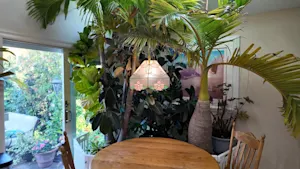More Stories
Our gardens are covered with leaves and plants ready for a long winter nap, but there are certain things you need to do now for success in spring!
November has a reputation for being a cold month, but many people don't realize temperatures in November are very similar to our average April weather. However, the sun is only as strong now as it is in late February. November is also a month of significant change. Temperatures will drop faster in the next few weeks than they do any other time of the year. Our gardens are getting messy with leaves and plants ready to rest for the winter, but tidying up could do more harm than good if you don't follow these tips.
Go easy on the pruning
Autumn is the ideal time to prune deciduous trees (think maples, apples, roses) because it is easier to see their branching structure. If you don't want to leave your ornamental grasses for wintertime, you can prune these back, too. But there are a lot of plants you can harm if you prune too hard this time of the year.
WATCH NEXT: This shrub blooms more than any other
Most evergreens prefer to be pruned in late winter or early spring, and I'd wait to prune any spring blooming shrubs until late spring. Azaleas, camellia, andromeda and rhododendrons all have dormant flower buds now. If you prune them in autumn, you won't get blooms in the spring from these plants. Pruning encourages growth and leaves plants susceptible to diseases, so it's best not to prune evergreens during cooler months.
It's OK to prune trees that lose their leaves because these are dormant during the winter. The exception is hydrangeas because they set their flower buds in autumn. You can't see the buds now, but if you prune the stems back too far, you will not get blooms.
My favorite plant to snip: Lavender
I love bringing lavender into the house this time of year. It smells incredible and puts me in such a great mood, but don't get too overzealous with pruning these. Never prune lavender back to the woody base or it won’t sprout again. I only snip a few fresh stems to bring inside for fragrance. That’s all you need!
Collect seeds!
If you have flowering annuals like zinnias, you probably noticed the dried flowerheads. Underneath each of those petals are seeds. You can leave the flowerheads in place or you can cut them and save the seeds for next year. Either way, you'll probably end up with seedlings sprouting around the yard in the spring if you leave these in place.
Fall is for planting
If you’re in the mood to plant instead of prune, you are in luck. Autumn is the best time of year to plant trees and shrubs that go dormant during our winters. Evaporation rates are lower and the soil is warm enough for some root growth before winter. This gives plants a really good foundation for spring growth and several months before the heat returns.
The dangers of bagging your leaves
One of the biggest mistakes I see people make in fall is removing every last leaf from their property. According to a 2025 University of Maryland study, removing all leaf litter from your yard can reduce the spring emergence of butterflies and moths by up to 45%. And that means fewer birds, because fewer caterpillars and insects are around for them to eat. Unfortunately, shredding the leaves also had the same impact on wildlife as removing the leaves altogether, according to the study.
If you're looking to keep things tidy, I recommend raking leaves into garden beds. They'll decompose over the winter and give wildlife a safe place to overwinter. Any leftover leaves in spring can be used to fill garden containers, which will save you money on potting soil next season. Moving the leaves instead of removing the leaves is a lot less work and will keep your pavement safe from slippery leaves on wet autumn days.
What to know
Fall is all about rest, for our garden and for gardeners. It's OK to go light on autumn chores or leave the garden alone altogether. All those leftover bits of garden litter will be a safe haven for wildlife, and it can even prevent weeds from taking a footing in the spring.
Happy gardening!
More from News 12
1:53

Balsam vs. fraser: Which Christmas tree is best for your home?
1:22

Decorating Trees for the Holidays can damage them
1:43

Holiday porch decorating with things around your yard!
1:35

How to plant garlic: It's easy, tasty & loves the cold!
1:33

How to plant spring bulbs this autumn (or grow them indoors this winter!)
1:47
